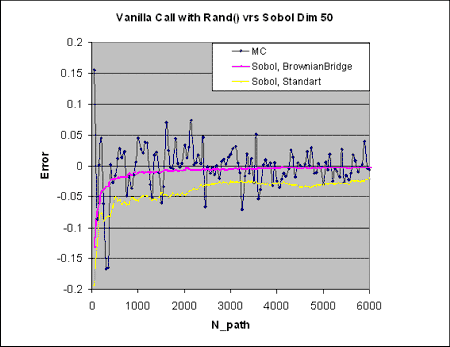
Applications
A comparison of Monte Carlo and Quasi-Monte Carlo
methods for option pricing
In this study we consider European call options. Computation of other options and risk measures (Gammas) are presented here and here. European call option provides the holder of the option with the right to buy the underlying asset by a certain date for a given price known as the strike price. The date in the contract is known as the maturity. The payoff function is the following:
In a risk-neutral environment, the value of a derivative is the discounted value of its expected terminal date cash flow:
Monte Carlo simulation approximates the expectation of the derivative's terminal cash flows with an arithmetic average of the cash flows taken over a finite number of simulated price paths:
Numerical results and discussion
| Asset, t=0 | 100 |
| Volatility | 20.00% |
| Int. rate | 5.00% |
| Strike | 100 |
| Expiry | 0.5 [years] |
| Black-Scholes Value: 6.88 | |
Call(Expiry) =
exp(-5% * 0.5) * max(AssetPrice – 100,0)
Simulation Parameters:
Time-Step size: 0.01 years
Number of time steps: 50
Number of paths: 6,000

Fig. 1: Price of European Call versus the number of paths obtained using MC and QMC methods with Standard and Brownian Bridge approximations.

Fig. 2: Relative error versus the number of paths for MC and QMC methods with Standard and Brownian Bridge approximations.

Fig. 3: Log-log plot of the absolute value of the relative error versus the number of paths for QMC methods with Standard and Brownian Bridge approximations.
Results show superior performance of the QMC approach based on SobolSeq with the Brownian Bridge approximation. The convergence rate for the Brownian Bridge approximation decreases as 1/N0.82, while for the Standard approximation this rate is only 1/N0.4.
Broda's generator was used for simulation.
Files for Download
![]() Risk measures computation with QMC
Risk measures computation with QMC
![]() Options and Greeks computation with QMC
Options and Greeks computation with QMC
![]() CVA and CVA Sensitivities using QMC
CVA and CVA Sensitivities using QMC
![]() Comparison of BRODA and JOE&KUO SOBOL' sequence generators
Comparison of BRODA and JOE&KUO SOBOL' sequence generators
![]() Comparing Option Pricing Methods in q
Comparing Option Pricing Methods in q
![]() Pricing and Risk Analysis in Hyperbolic LocVol with QMC
Pricing and Risk Analysis in Hyperbolic LocVol with QMC
![]() Quasi-Monte Carlo Methods for Calculating Derivatives Sensitivities on the GPU
Quasi-Monte Carlo Methods for Calculating Derivatives Sensitivities on the GPU
![]() The importance of being scrambled: supercharged Quasi Monte Carlo
The importance of being scrambled: supercharged Quasi Monte Carlo
![]() Effective dimensionality reduction for Greeks computation using Randomized QMC
Effective dimensionality reduction for Greeks computation using Randomized QMC